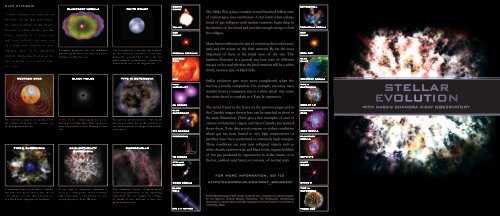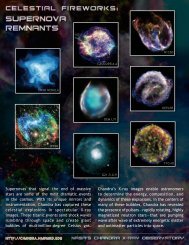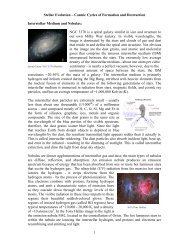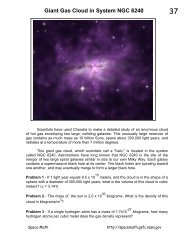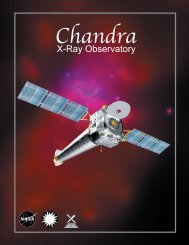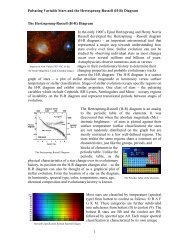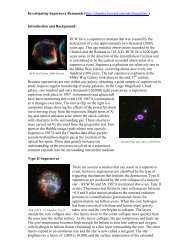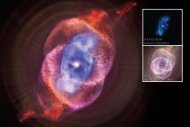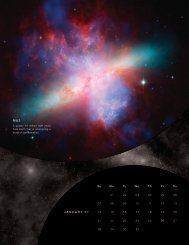Stellar evolution - Chandra X-ray Observatory
Stellar evolution - Chandra X-ray Observatory
Stellar evolution - Chandra X-ray Observatory
Create successful ePaper yourself
Turn your PDF publications into a flip-book with our unique Google optimized e-Paper software.
END PHASES<br />
A star’s ultimate fate depends on<br />
its mass. It can fade into obscurity<br />
(brown dwarf or red dwarf),<br />
become a white dwarf (sun-like<br />
stars), explode as a supernova<br />
and leave behind a neutron star<br />
or a black hole (massive to very<br />
massive stars), or be disrupted<br />
entirely (white dwarfs in close binary<br />
systems, or extremely massive<br />
stars).<br />
neutron Star<br />
An extremely compact star produced by<br />
the collapse of the core of a massive star<br />
in the supernova process.<br />
type ii Supernova<br />
A supernova that occurs when a massive<br />
star has used up its nuclear fuel and its<br />
core collapses to form either a neutron star<br />
or a black hole, triggering an explosion.<br />
planetary neBula<br />
A nebula produced after an exhausted<br />
giant star puffs off its outer layer and leaves<br />
behind a smaller, hot star.<br />
Black HoleS<br />
If the core of a collapsing star has a mass<br />
that is greater than three Suns, no known<br />
force can prevent it from forming a black<br />
hole.<br />
pair-inStaBility<br />
Supernova<br />
A rare type of explosion predicted to<br />
occur as a consequence of the extremely<br />
high temperatures in the interiors of stars<br />
having masses of about 200 suns.<br />
WHite DWarf<br />
The end phase of a Sun-like star in which<br />
all the material contained in the star,<br />
minus the amount blown off in the red<br />
giant phase, is packed into a volume one<br />
millionth the size of the original star.<br />
type ia Supernova<br />
An explosion produced when a white dwarf<br />
becomes unstable due to the accretion of<br />
too much material or merger with another<br />
white dwarf.<br />
SuperSHellS<br />
The combined activity of many stellar<br />
winds and supernovas create expanding<br />
supershells that can trigger the collapse<br />
of clouds of dust and gas to form new<br />
generations of stars.<br />
BroWn<br />
DWarf<br />
tWa 5B<br />
reD<br />
DWarf<br />
proXima centauri<br />
Sun-like<br />
Star<br />
Sun<br />
pair-<br />
inStaBility<br />
Sn 2006Gy<br />
Blue<br />
SuperGiant<br />
eta carinae<br />
protoStar<br />
tW HyDrae<br />
<strong>Stellar</strong><br />
nurSery<br />
orion neBula<br />
Black<br />
Hole<br />
Xte J1118+480<br />
The Milky Way galaxy contains several hundred billion stars<br />
of various ages, sizes and masses. A star forms when a dense<br />
cloud of gas collapses until nuclear reactions begin deep in<br />
the interior of the cloud and provide enough energy to halt<br />
the collapse.<br />
Many factors influence the rate of <strong>evolution</strong>, the <strong>evolution</strong>ary<br />
path and the nature of the final remnant. By far the most<br />
important of these is the initial mass of the star. This<br />
handout illustrates in a general way how stars of different<br />
masses evolve and whether the final remnant will be a white<br />
dwarf, neutron star, or black hole.<br />
<strong>Stellar</strong> <strong>evolution</strong> gets even more complicated when the<br />
star has a nearby companion. For example, excessive mass<br />
transfer from a companion star to a white dwarf may cause<br />
the white dwarf to explode as a Type Ia supernova.<br />
The terms found in the boxes on the previous pages and in<br />
the <strong>Chandra</strong> images shown here can be matched to those in<br />
the main illustration. These give a few examples of stars at<br />
various <strong>evolution</strong>ary stages, and what <strong>Chandra</strong> has learned<br />
about them. X-<strong>ray</strong> data reveal extreme or violent conditions<br />
where gas has been heated to very high temperatures or<br />
particles have been accelerated to extremely high energies.<br />
These conditions can exist near collapsed objects such as<br />
white dwarfs, neutron stars, and black holes; in giant bubbles<br />
of hot gas produced by supernovas; in stellar winds; or in<br />
the hot, rarified outer layers, or coronas, of normal stars.<br />
f o r m o r e i n f o r m a t i o n , g o t o:<br />
h t t p://c h a n d r a .s i.e d u /x r a y_s o u r c e s /<br />
NASA’s Marshall Space Flight Center, Huntsville, Ala., manages the <strong>Chandra</strong> program<br />
for the agency’s Science Mission Directorate. The Smithsonian Astrophysical<br />
<strong>Observatory</strong> controls science and flight operations from the <strong>Chandra</strong> X-<strong>ray</strong> Center in<br />
Cambridge, Mass.<br />
SuperSHell<br />
tarantula neBula<br />
reD<br />
Giant<br />
Beta ceti<br />
Blue<br />
Giant<br />
creScent neBula<br />
type ii<br />
Supernova<br />
G292.0+1.8<br />
neutron<br />
Star<br />
craB neBula<br />
planetary<br />
neBula<br />
cat’S eye<br />
WHite<br />
DWarf<br />
SiriuS B<br />
type ia<br />
Supernova<br />
tycHo Snr<br />
<strong>Stellar</strong><br />
<strong>evolution</strong><br />
with NASA’s ChANdrA X-rAy ObServAtOry
+<br />
MASS<br />
stellar<br />
nursery<br />
protostar<br />
protostar<br />
protostar<br />
protostar<br />
protostar<br />
Protostar<br />
protostar blue supergiant<br />
blue supergiant<br />
blue supergiant<br />
pair-instability<br />
type ii supernova<br />
blue supergiant red giant<br />
black hole<br />
blue giant<br />
black hole<br />
type ii supernova<br />
sun-like star red giant planetary nebula<br />
red dwarf red dwarf<br />
supershell<br />
neutron<br />
star<br />
type ia supernova<br />
white<br />
dwarf<br />
brown dwarf brown dwarf<br />
tiMe<br />
white<br />
dwarf<br />
Illustration: NASA/CXC/M. Weiss<br />
stellar<br />
nursery<br />
– +<br />
<strong>Stellar</strong> nurSery<br />
Large cold clouds of dust and gas where<br />
stars form.<br />
reD DWarf<br />
A star with a mass approximately 8% and<br />
50% of the mass of the Sun.<br />
reD Giant<br />
A phase in the <strong>evolution</strong> of a star after<br />
nuclear fusion reactions that convert<br />
hydrogen to helium have consumed all<br />
the hydrogen in the core of the star, and<br />
energy generated by hydrogen fusion in<br />
the shell causes the star’s diameter to<br />
greatly expand and cool.<br />
protoStarS<br />
The stage in the formation of a star just<br />
before nuclear reactions ignite.<br />
Sun-like Star<br />
A star with mass between about 50% and 10<br />
times that of the Sun<br />
Blue Giant<br />
After a massive red giant star ejects its<br />
outer layers, its hot inner core is exposed,<br />
and it becomes a blue giant star.<br />
BroWn DWarf<br />
An object with a mass less than about 8%<br />
of the mass of the Sun, but about 10 times<br />
greater than that of Jupiter.<br />
Blue SuperGiantS<br />
Stars much more massive than the Sun.<br />
iNterMediAte<br />
PhASe


